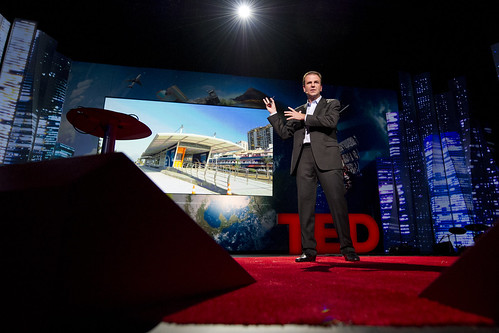Eduardo Paes became the mayor of Rio de Janeiro in 2008. He shares his four commandments for ensuring that cities are a great place to live.
1. A city of the future has to be environmentally friendly
“Every time you think of a city, you have to think green, green, green,” says Paes. “Every time you see concrete jungle you must find open spaces. And when you find open spaces, make it so people can get to them.” This thinking is why he’s spearheading the creation of the third largest urban park in Rio, due to open by June 2012.
2. A city of the future has to deal with mobility and integration of its people
By their nature, cities are packed with people, which means that high-capacity transportation is critically important. An issue with this, of course, is that such systems cost a lot of money. He references a project to redesign the urban plan of Curitiba, Brazil, that Jaime Lerner presented at TED in 2007, now being co-opted in the name of Rio’s systems. 63% of the population will be carried by the new system by 2015. “You don’t have to be rich or powerful to get things underway,” he says. “You need to be original.”
3. A city of the future has to be socially integrated
Paes acknowledges the favelas that are prominent in Rio. But, he adds, they are not always a problem. And if you deal with them properly, he maintains that they can even be their own solution. He needs this to be so: as he acknowledges, 1.4 million of Rio’s 6.3 million inhabitants live in favelas. “They’re all over the city.” But he maintains that you can change the vicious circle to a virtuous one if you bring education, health–and open spaces–into the favelas. His aim is to “urbanize” the favelas by 2020.
4: A city of the future has to use technology to be present
Paes shouldn’t be in Long Beach, he says. After all, it’s high season in Rio. But, he can be here because technology allows him to be. To prove it, he calls his secretary of urban affairs in Rio, who broadcasts some of the urban tracking system from the city’s Operation Center. This allows him (and us) to check up on the state of the city, on the weather (all looking good), the traffic (it’s 11pm; all moving smoothly) and even on the location of the city’s waste collection trucks, which appear to be stationed around the city nicely. This means Paes can keep an eye on what’s going on, even when he’s not there.
To sum up, he emphasizes his enthusiasm for cities of any size. “At the end of the day, we talk about the gathering of people. We cannot see that as a problem. It’s fantastic,” he says. “The city of the future is a city that cares about its citizens and integrates its citizens.”
Photo: James Duncan Davidson

Comments (7)
Pingback: Conectatelatino | Rio Olympics a shame, says Mayor Eduardo Paes
Pingback: curitiba — sustainapedia
Pingback: Are Urban Green Spaces Good for City? « Rashid's Blog
Pingback: NYTimes Reports on Forced Evictions in Rio, But Serious Questions Remain : Video For Change
Pingback: Mayor of Rio describes his four commandments for cities of the future « Noticias – sambazayres.com